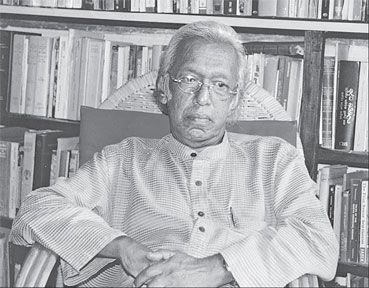Indelible marks on a brilliant academic career
By Dr. Saliya Kularathne
Since obtaining his PhD from the University of Halle in Germany in
1965 on a scholarship, Prof. Anuradha Seneviratne had passed many a
milestones in his trailblazing academic career which spread over many
fields.
|

Prof. Anuradha Seneviratne |
A singular facet of his academic career was that he had achieved
pinnacle which still seem an unreachable targets or milestones for many
academics.
He was an internationally renowned author who was awarded the coveted
title Kalakeerthi in 1994 by the Government of Sri Lanka. Malwatu
Viharaya of Kandy awarded him the honorary title Dharmashastra
Visharadha Keerthi Sri in recognition of his contribution to the
scholarship. The philosophical background in the system of University in
Sri Lankan is Western oriented and therefore, it does not consider an
individual's inner spiritual powers.
Although Indian and Tibetan traditions recognise the Extra Sensory
Perception, in the Western tradition, entire process of mind is confined
to the notion of Psycho- biophysical.
A little know fact about Prof. Anuradha Seneviratne's life was that
once, a team of Brahmins from India (Nadivakyam readers) who used to
make an annual visit to Colombo and stayed at Borella and revealed that
Prof. Seneviratne was an erudite Brahmin in India in his previous
existence and he had a profound knowledge of Vedanta.
Upanishad
Although this was not possible to verify this fact independently, it
was revealed that Prof. Seneviratne had, in fact, written a book titled
Upanishad in Sinhala at the tender age of 17 as a teenager.
The book has already gone into its second impression. The book was
printed in 1961 and the content included gradual evolution of Upanishad
such as Chandogya Upanishad, Brihadaranyaka, Mundaka Upanishad.
It is indeed interesting and awe-inspirting to note that a
17-year-old youth had written such an in-depth thesis on Upanishad.
Prof. Seneviratne had written over 70 academic publications on
Sinhala folklore and Sinhala literature in both Sinhala and English.
In addition, he had written over 300 articles to academic journals. A
collection of articles Prof. Seneviratne wrote to newspapers over the
years was published in 2006 as Gnana Dharsana by Godage Publishers.
The collection of articles covered the diverse areas of ancient and
contemporary Sinhala culture.
His publications on Sinhalese culture shed light on diverse aspects
of ancient Sinhalese civilisation.
Some of them are Vatadage, Kandy, ancient city of Anuradhpura,
capital city in Polonnaruwa, Rangiri Dambulu Rajamaha Vihara, Sinhalese
hydraulic civilisation, Mihintale and the Buddha. Seminal publications
among them are 'Monastic City-Anuradhapura' and ' Medieval Sinhalese
City-Polonnaruwa'.
Dharshani Gunatilake and I had the privilege of translating
''Monastic City-Anuradhapura' as 'Purana Anuradhapuraya' into Sinhala.
It had been a great academic exercise for us as Assistant lecturers
on the academic staff of the university. It was Dr. Damayanthi
Gunasekara who translated 'Medieval Sinhalese City-Polonnaruwa' into
Sinhala.
Later, Prof. Seneviratne entrusted me with the task of editing the
Sinhala translation by Dr. Damayanthi Gunasekara.
By then, I had gained substantial exposure to translation after
translating ''Monastic City-Anuradhapura' as 'Purana Anuradhapuraya'
into Sinhala.
It is with gratitude that I recalled the profitable exercise of
translation which invariably cemented my inherent interests in studying
Sinhalese culture. However, in 2007, Prof. Seneviratne embarked on a
different type of academic exercise.
It was the translation of Sanskrit book of poetry 'Mayurashtaka' by
Mayura into Sinhala as 'Ninida Pahankala Ra'. Prof. Seneviratne has
chosen appropriate illustrations by Jorge Keet for the extremely
passionate book of poetry.
His extensive knowledge of Kandy Dalada Perahera and the Temple of
the Tooth was amply manifested in his book titled ' The Temple of the
Tooth Relic". His booklet 'Kandy Esala Perehara' discusses the history
of Esala Perahera and its evolution. |


